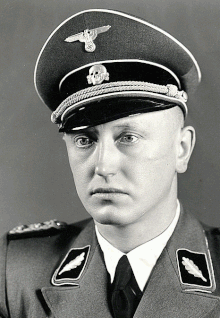Hans-Ulrich Geschke

Hans-Ulrich Geschke (born May 16, 1907 in Frankfurt (Oder) ) was a German lawyer, Gestapo officer and SS-Oberführer (1944) who was involved in the Holocaust of the Hungarian Jews .
Life
After attending school, Geschke studied law at the universities of Tübingen , Berlin and Göttingen . He received his doctorate in 1931 at the University of Göttingen with the dissertation The liability of third parties for damage caused by breach of contract or tort against the commission of damage principals to Dr. jur .
He was a member of the NSDAP (membership number 945.891). From February 1935 to 1938 Geschke was head of the Kiel Stapo and then the Stapo in Saarbrücken . After the " smashing of the rest of the Czech Republic ", Geschke was transferred to the Protectorate of Bohemia and Moravia in Prague , where he became head of the Gestapo there (see Special Action Prague ). Geschke was promoted to the Upper Government Council in 1941. Geschke coordinated a major manhunt after the Heydrich assassination attempt . In September 1942 Ernst Gerke succeeded Geschke as head of the Prague Gestapo.
In autumn 1942 Geschke became inspector of the Security Police and the SD in Posen and on December 17, 1942, moved to Dresden in the same function .
On March 19, 1944, the day Hungary was occupied by German troops, Geschke was appointed commander of the Security Police and the SD (BdS) under SS-Obergruppenführer Otto Winkelmann . From an organizational point of view, he was the supervisor of the Eichmann Command , but Eichmann operated largely independently of him.
With the help of the Budapest telephone directory, among other things, he had 200 names that sounded suspicious of Jews identified, if possible with doctoral degrees. These people - mostly doctors and lawyers - were arrested immediately, and in the evening he reported the arrest of a total of 2,000 leading officials of Hungarian Jewry in Berlin.
Geschke went into hiding after the war and was declared dead in 1959 by the public prosecutor's office in Frankfurt (Main) (4 Js 1017/59 OStA Ffm). Allegedly he died in the Battle of Budapest .
literature
- Gerhard Paul : State terror and social brutality. The Gestapo in Schleswig-Holstein. With the collaboration of Erich Koch. Results, Hamburg 1996, ISBN 3-87916-037-6 .
- Jan Björn Potthast: The Jewish Central Museum of the SS in Prague - Opponent Research and Genocide under National Socialism. Campus-Verlag, Munich 2002, ISBN 3-593-37060-3 .
- Ernst Klee : The dictionary of persons on the Third Reich . Who was what before and after 1945 . 2nd Edition. Fischer-Taschenbuch-Verlag, Frankfurt am Main 2007, ISBN 978-3-596-16048-8 .
Web links
- Literature by and about Hans-Ulrich Geschke in the catalog of the German National Library
Individual evidence
- ^ A b c Gerhard Paul : State terror and social brutalization. The Gestapo in Schleswig-Holstein. Hamburg 1996, p. 100.
- ↑ Numery członków SS od 107 000 do 107 999. podana jest najwyższa udokumentowana ranga jakią uzyskali n / w członkowie SS wszystkie pozostałe są nadal uzupełniane. Retrieved May 19, 2019 (Polish).
- ^ Ernst Klee : The dictionary of persons on the Third Reich. Frankfurt am Main 2007, p. 181 f.
- ↑ Jan Björn Potthast: The Jewish Central Museum of the SS in Prague - Opponent Research and Genocide under National Socialism. Munich 2002, p. 303.
| personal data | |
|---|---|
| SURNAME | Geschke, Hans-Ulrich |
| BRIEF DESCRIPTION | German Gestapo officer involved in the Holocaust of the Hungarian Jews |
| DATE OF BIRTH | May 16, 1907 |
| PLACE OF BIRTH | Frankfurt (Oder) |
| DATE OF DEATH | after 1945 |